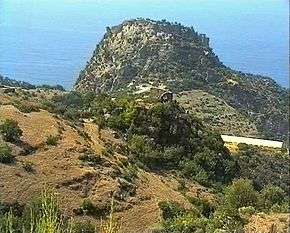Antiochia ad Cragum
 Some ruins at Antiochia ad Cragum | |
 Shown within Turkey | |
| Alternate name | Antiochetta, Antiocheta, Antiochia Parva, Antiocheta in Rufine |
|---|---|
| Location | Antalya Province, Turkey |
| Region | Cilicia |
| Coordinates | 36°09′26″N 32°24′56″E / 36.15722°N 32.41556°ECoordinates: 36°09′26″N 32°24′56″E / 36.15722°N 32.41556°E |
| Type | Settlement |
| History | |
| Founded | 170 BC |
| Cultures | Hellenistic, Roman, Armenian, Byzantine, Medieval |
| Site notes | |
| Excavation dates | 2005-2015 |
| Archaeologists | Michael Hoff, Rhys Townsend, Ece Erdoğmuş, Birol Can |
| Condition | In ruins |
| Management | University of Nebraska–Lincoln |
Antiochia ad Cragum (Greek: Αντιόχεια του Κράγου) also known as Antiochetta or Latin: Antiochia Parva (meaning "Little Antiochia") is an ancient Hellenistic city on Mount Cragus overlooking the Mediterranean coast, in the region of Cilicia, in Anatolia. In modern-day Turkey the site is encompassed in the village of Güneyköy, District of Gazipaşa, Antalya Province.
The city was founded by Antiochus IV Epiphanes in approximately 170 BC. It minted coins from the mid-1st century to the mid-2nd century; the last known of which were issued under Roman Emperor Valerian. The city became part of the kingdom of Lesser Armenia in the 12th century. In 1332, the Knights Hospitallers took the city, after which it was known variously as Antiochetta, Antiocheta, Antiocheta in Rufine (Papal bull of Pope John XXII), and Antiochia Parva.
Some scholars claim an identity of Antiochia ad Cragum with the city Cragus (Kragos) or, although it lies more than 100 km away, with Sidyma, which some scholars assert was the Lycian Cragus (Kragos).
Ruins of the city remain, and include fortifications, baths, chapels, Roman necropolis, and the largest Roman mosaic found in Turkey.[1]
Bishopric

In Byzantine times, Antiochia Parva was the seat of an episcopal see of the Roman province of Isauria in the Diocese of the East. It was part of the Patriarchate of Antioch and was suffragan of the Archbishopric of Seleucia.
There are five known ancient bishops of this diocese:
- Antonius took part in the First Council of Nicaea in 325;
- Theodosius in the First Council of Constantinople in 381;
- Acacius was among the fathers of the Council of Chalcedon in 451;
- Zacharias took part in the Trullan Council of 692; and
- Theophanes finally witnessed the council held in Constantinople in 879–880 that rehabilitated the patriarch Photius of Constantinople.[2]
The Roman Catholic Diocese of Antiochia Parva is no longer a residential bishopric. It is today listed as a suppressed and titular see of the Roman Catholic Church.[3][4] The seat is vacant since April 11, 1964. It was held previously by:
- Jacques-Eugène Louis Ménager (June 23, 1955 – December 7, 1961)
- André-Jean-Marie Charles de la Brousse (January 26, 1962 – April 11, 1964)[notes 1]
Notes
References
- ↑ NBC News.com 09/21/13
- 1 2 Michel Lequien, Oriens christianus in quatuor Patriarchatus digestus, Paris 1740, Vol. II, coll. 1017-1020
- ↑ Pius Bonifacius Gams, Series episcoporum Ecclesiae Catholicae, Leipzig 1931, p. 438
- ↑ Annuario Pontificio 2013 (Libreria Editrice Vaticana 2013 ISBN 978-88-209-9070-1), p. 834